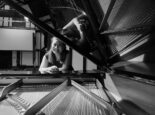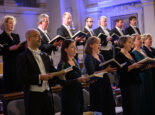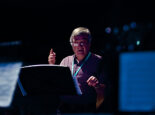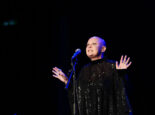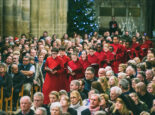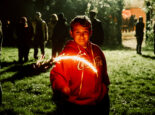Glass, Light, Paint & Clay
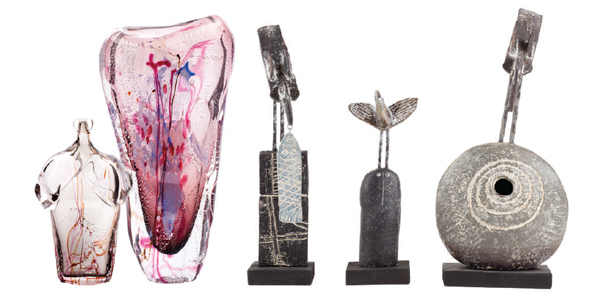
Vivacity’s City Gallery (within Peterborough Museum), is hosting a first with its Glass, Light, Paint & Clay exhibition. This eclectic exhibition draws together four of Britain’s finest post-war artists whose sum, collector Dr Graham Cooley believes, is better than their parts. The Moment caught up with Graham to find out what Peterborough’s art lovers can expect
Let’s start, Graham, with a little introduction to you. How did you get into collecting art?
It started about 30 years ago as an alternative form of investing. But I’m primarily a collector, which means I buy things because they appeal to me. It probably started with my collecting Whitefriars Glass. You could easily buy it back then, but suddenly it became incredibly rare and sought after. I felt that I’d made a good decision by getting in early. My main interest is in identifying things that have been undervalued or not properly understood. I buy a lot of journals, such as Crafts Magazine or Ceramics Review, then look back at all the really fantastic designers and makers that were featured in them. My primary interest is in understanding those designers. So I look at people that have either disappeared or been misunderstood, and sort of reposition them.
Being able to trend spot like that is very impressive.
Collecting is a bit like being a detective, particularly if you’re faced with a whole mass of stuff. Everything you see has been designed and made by somebody. The question is, which of those things were quintessential or iconic of their time? Which of them are well designed?
Glass, Light, Paint & Clay features four of your favourite artists: Bernard Rooke, John Maltby, Duncan Clarke and Sam Herman. What is it about their work that particularly appeals to you?
This is the first time that any of my objects from these four artists have been displayed. It’s a slight departure from my normal strategy in that all of these artists are actually living! Bernard Rooke comes from the sixties movement you might call Brutalism. He produces really fantastic ceramics made in a functional way. So rather than just making sculptures, he made sculptures then turned them into lamp bases. So what he’s doing is making functional objects from what I would say are very beautiful sculptures. Bernard’s work has gone on to influence a whole generation of ceramicists. John Maltby is at the same time incredibly modern and very ancient. When I mean ancient, I mean his figures look almost Saxon to me. They look intimidated by their environment, vulnerable. It’s interesting when you look at his pieces – there are women carrying babies, people on boats, so elements of the sea and nature. One of the things he does well is place the human in nature.
Sam Herman is a very influential glass artist who brought studio glass to the UK. He was head of glass at the RCA [Royal College of Art] at the time when the RCA was doing incredible things. He is the only glass artist in the country to have had an exhibition at the Victoria and Albert Museum. Finally there’s Duncan Clarke. Duncan is all about the impact of humans on the landscape. He understands intensive farming and the effects of chemicals and farming on the British countryside. As an ecologist and conservationist he also does things like track the number of butterflies and birds to contribute to national schemes. His work is a very colourful representation of British painting, taking influence from painters of the 1920s-30s, such as Graham and Paul Nash or Edward Bawden.
They are all very different. Why have you chosen to exhibit such a variety of artwork in one exhibition?
Exhibitions are normally of paintings or ceramics or glass. This exhibition combines all of those things together. So what you’re getting is Bernard Rooke’s incredibly important period lighting, studio glass from Sam Herman, John Maltby’s studio ceramics and painting from Duncan Clarke – all together. They are each doing something different and play off against each other, but I think they are all very complementary of each other too. Exhibitions position objects, they remind people about the objects. An object never looks better than when it is part of a group, where that group brings out some of its aspects.
Have you got any tips for aspiring collectors?
Find some period books and journals and read around the subject. Find something you really like then research it some more. If you’re going to buy beautiful things, it’s worth buying objects that you love yourself in an informed way. That means understanding who made it and when, how it fits into the culture of the time, who the designer was – all those things that give you real context. It’s the context around an object that really brings it alive.
Glass, Light, Paint & Clay City Gallery
Priestgate, Peterborough PE1 1LF
Vivacity presents an exceptional display featuring four notable British artists from Graham Cooley’s eclectic collection. Cooley’s unique selection of artworks reveals his broad taste across both visual and decorative arts, portraying the extraordinary level of craftsmanship that has emerged from the UK.
Runs until 14 Dec, Tues-Sun, 10am-5pm
01733 864663, www.vivacity-peterborough.com/city-gallery
Hot Stuff!
The Birth of Studio Glass Peterborough Museum, Priestgate, Peterborough PE1 1LF
In connection with the exhibition from the Graham Cooley Collection, Mark Hill will be delivering a talk on decorative glass at Peterborough Museum. Mark Hill is a publisher, TV presenter, and leading dealer in post-war Czech and 20th century decorative glass. Although glass has been made for centuries, the 1960s saw a revolution in the way it was made, opening it up to artists across the world and allowing for unprecedented creativity. After looking at the historical context and the genesis of the movement, Mark will examine the work of six key glass artists, including Sam Herman, Dale Chihuly, and Peter Layton. ‘I’m delighted to be taking part in what I am sure will be a pioneering exhibition from Graham Cooley and the Vivacity City Gallery,’ says Mark. ‘Studio glass is one of the most vibrant and colourful parts of 20th century design and the contemporary art market, and Sam Herman is right at the core, having been a key figure from the genesis of the movement in the UK in the 1960s. His sculptural work exemplifies the art, and is full of vigour and life, as well as being celebrated internationally. Ideal for the beginner and collector alike, my talk will reveal the story behind the movement and put it into context, with plenty of take-home tips and tricks.’
Tues 21 Nov, 6pm
Spaces are limited so booking in advance is recommended
Tickets £6, available from Peterborough Museum or by calling 01733 864663









